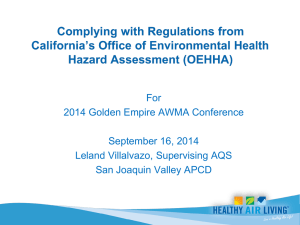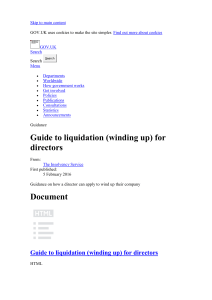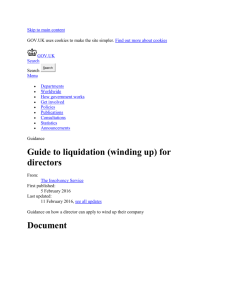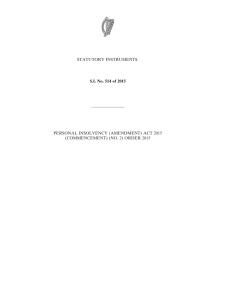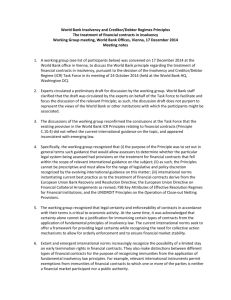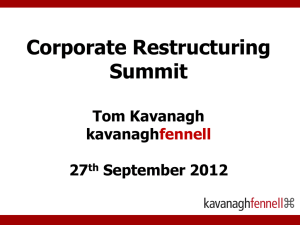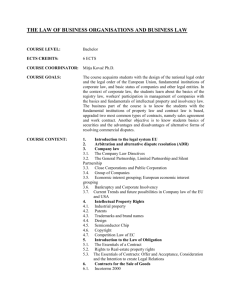Predictive Model of Insolvency Risk for Australian Corporations
advertisement
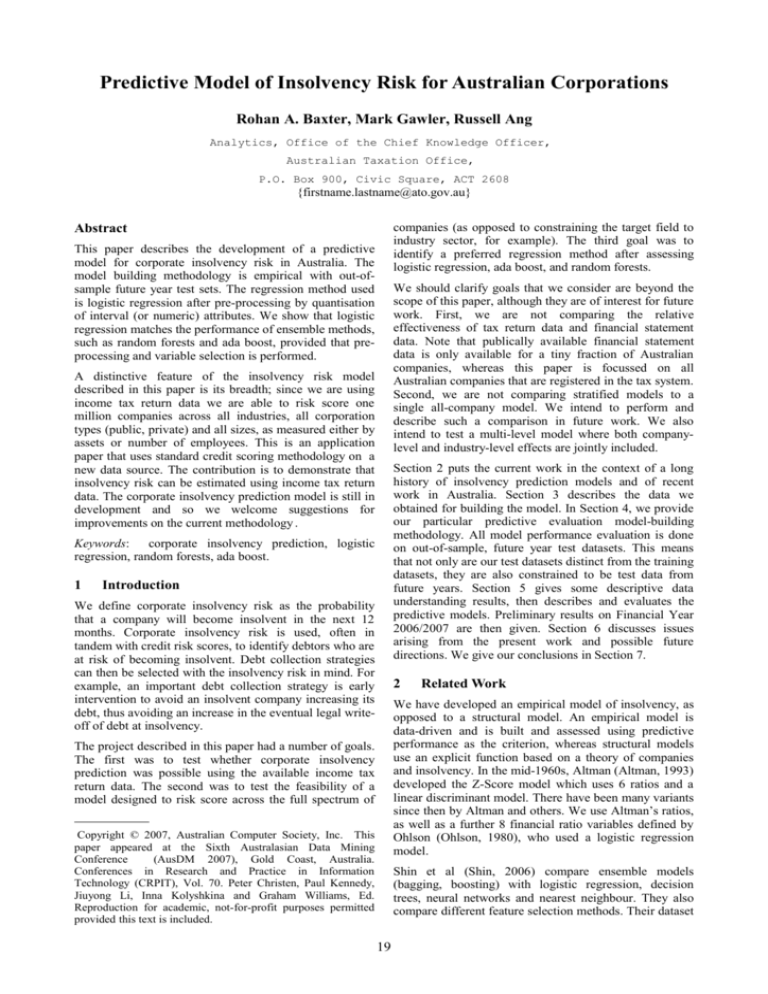
Predictive Model of Insolvency Risk for Australian Corporations
Rohan A. Baxter, Mark Gawler, Russell Ang
Analytics, Office of the Chief Knowledge Officer,
Australian Taxation Office,
P.O. Box 900, Civic Square, ACT 2608
{firstname.lastname@ato.gov.au}
companies (as opposed to constraining the target field to
industry sector, for example). The third goal was to
identify a preferred regression method after assessing
logistic regression, ada boost, and random forests.
Abstract
This paper describes the development of a predictive
model for corporate insolvency risk in Australia. The
model building methodology is empirical with out-ofsample future year test sets. The regression method used
is logistic regression after pre-processing by quantisation
of interval (or numeric) attributes. We show that logistic
regression matches the performance of ensemble methods,
such as random forests and ada boost, provided that preprocessing and variable selection is performed.
We should clarify goals that we consider are beyond the
scope of this paper, although they are of interest for future
work. First, we are not comparing the relative
effectiveness of tax return data and financial statement
data. Note that publically available financial statement
data is only available for a tiny fraction of Australian
companies, whereas this paper is focussed on all
Australian companies that are registered in the tax system.
Second, we are not comparing stratified models to a
single all-company model. We intend to perform and
describe such a comparison in future work. We also
intend to test a multi-level model where both companylevel and industry-level effects are jointly included.
A distinctive feature of the insolvency risk model
described in this paper is its breadth; since we are using
income tax return data we are able to risk score one
million companies across all industries, all corporation
types (public, private) and all sizes, as measured either by
assets or number of employees. This is an application
paper that uses standard credit scoring methodology on a
new data source. The contribution is to demonstrate that
insolvency risk can be estimated using income tax return
data. The corporate insolvency prediction model is still in
development and so we welcome suggestions for
improvements on the current methodology .
Section 2 puts the current work in the context of a long
history of insolvency prediction models and of recent
work in Australia. Section 3 describes the data we
obtained for building the model. In Section 4, we provide
our particular predictive evaluation model-building
methodology. All model performance evaluation is done
on out-of-sample, future year test datasets. This means
that not only are our test datasets distinct from the training
datasets, they are also constrained to be test data from
future years. Section 5 gives some descriptive data
understanding results, then describes and evaluates the
predictive models. Preliminary results on Financial Year
2006/2007 are then given. Section 6 discusses issues
arising from the present work and possible future
directions. We give our conclusions in Section 7.
Keywords: corporate insolvency prediction, logistic
regression, random forests, ada boost.
1
Introduction
We define corporate insolvency risk as the probability
that a company will become insolvent in the next 12
months. Corporate insolvency risk is used, often in
tandem with credit risk scores, to identify debtors who are
at risk of becoming insolvent. Debt collection strategies
can then be selected with the insolvency risk in mind. For
example, an important debt collection strategy is early
intervention to avoid an insolvent company increasing its
debt, thus avoiding an increase in the eventual legal writeoff of debt at insolvency.
2
Related Work
We have developed an empirical model of insolvency, as
opposed to a structural model. An empirical model is
data-driven and is built and assessed using predictive
performance as the criterion, whereas structural models
use an explicit function based on a theory of companies
and insolvency. In the mid-1960s, Altman (Altman, 1993)
developed the Z-Score model which uses 6 ratios and a
linear discriminant model. There have been many variants
since then by Altman and others. We use Altman’s ratios,
as well as a further 8 financial ratio variables defined by
Ohlson (Ohlson, 1980), who used a logistic regression
model.
The project described in this paper had a number of goals.
The first was to test whether corporate insolvency
prediction was possible using the available income tax
return data. The second was to test the feasibility of a
model designed to risk score across the full spectrum of
Copyright © 2007, Australian Computer Society, Inc. This
paper appeared at the Sixth Australasian Data Mining
Conference
(AusDM 2007), Gold Coast, Australia.
Conferences in Research and Practice in Information
Technology (CRPIT), Vol. 70. Peter Christen, Paul Kennedy,
Jiuyong Li, Inna Kolyshkina and Graham Williams, Ed.
Reproduction for academic, not-for-profit purposes permitted
provided this text is included.
Shin et al (Shin, 2006) compare ensemble models
(bagging, boosting) with logistic regression, decision
trees, neural networks and nearest neighbour. They also
compare different feature selection methods. Their dataset
19
is restricted to 76 Turkish banks and their evaluation test
data does not use future year sample datasets. They
conclude that neural networks with appropriate feature
selection is competitive with ensemble models and
logistic regression on their Turkish bank dataset.
2.1
publicly available. There are at least seven different
stages in the insolvency process, ranging from voluntary
administration to liquidation. In our modelling process we
use the widest possible definition of insolvency and so
define a company to be insolvent if it enters any stage of
insolvency, even if only temporarily, during a financial
year.
Recent Australian models
Our principal interest is in predicting financial distress in
general rather than insolvency specifically. However, the
use of insolvency as the target variable has the advantage
of definiteness and objectivity. Nonetheless, it is a broad
target; there will many companies trading while insolvent
that do not actually go into administration. This is
consistent with David Hand’s hypothesis that financial
and customer modelling often involves ambiguous target
concepts (Hand, 2006).
Jones and Hensher (Jones and Hensher, 2004; Hensher,
Jones and Greene, 2007) have published a series of
papers using new methods for models of predicting
corporate insolvency. Their main focus is predictive
performance at a group level, rather than at the individual
company level. They note that predictive performance of
models has not improved greatly since the 1960s
(Hensher, Jones and Greene, 2007, p88). They observe
that a type II error rate (where a solvent company is
predicted to go insolvent) of 20% is typical for in-sample
modelling results and even higher for out-of-sample
future year results. In our project, a 20% type II error rate
is acceptable as long as the results are still actionable to
improve the operational efficiency of our business. One
reason to support this contention is that many of the
solvent companies in the 20% type II error category may
not be technically or legally insolvent, but instead, may be
financially distressed or even trading while insolvent. We
have confirmed this hypothesis using surrogate variables
for financial distress, such as level of indebtedness.
Australian Corporate Insolvencies (from our dataset)
7000
Number of Insolvencies
6000
3000
2000
1000
2004
2005
2006
2007
Financial Year
Figure 1: Insolvencies by Financial Year
3.2
Financial Ratio Variables
We adopt the financial ratio variables used by Altman
(Altman, 1993) and Ohlson (Ohlson, 1990). Their
financial data are obtained from audited financial
statements provided by companies to the relevant
corporate regulator (i.e. Securities Commission in the
U.S.). Since we are scoring both public and private
corporations, we need to exclude ratios using variables
that apply only to public companies, such as market value
of equity; data sources like those used by Altman and
Ohlson are inadequate for our purposes. Instead, we have
taken company income tax return data and adapted them
for use as financial ratios.
Moody’s has an existing corporate default model for
private companies, with 27K private companies in the
dataset (Moody’s, 2000; Moody’s, 2000a). Our
methodology mirrors Moody’s RiskCalc approach.
However, instead of audited financial statements we use
income tax return fields as data sources for financial
ratios. This allows us to score approximately one million
private companies. Moody’s early Australian model in
2000 achieved an Area under the ROC curve (AUC)
(Fawcett, 2004) of 0.7, compared with an AUC score of
0.93, as generated by the most recent version of our
model.
Given that tax financial data are different from accounting
financial statements, the question arose as to whether they
would be suitable for accurate insolvency risk prediction.
We shall see in the Results section that the results are
roughly comparable with those using audited financial
data. This is a useful and, as far as we know, novel
finding.
Data
The non-ratio financial variables used are:
Our population consists of active Australian companies,
which we define as those companies that have had at least
one income tax return since 2003. This covers about one
million companies from all industry sectors, all size
ranges and all corporation types, such as public and
private.
3.1
4000
0
Similarly to Hensher and Jones, Hossari’s PhD thesis
(Hossari, 2006), focuses on improving the methodology
in model building for predicting corporate collapse.
Hossari uses multi-level models with financial ratio data
extracted from audited financial statements. The data
selected is a balanced sample, matched by industry
classification, with fewer than 100 companies in the
dataset. Model assessment is done on the single sample.
Hossari found that vailable software for the multi-level
models didn’t scale well to larger datasets.
3
5000
1.
Total Assets.
2.
Net Income.
The two sets of financial ratio variabes that we have used
are:
Insolvency Target Variable
We obtain insolvency data from the Australian Securities
and Investments Commission (ASIC 2007). This data is
20
1.
Altman variables (Altman, 1968):
i.
Earnings before Tax and Interest / Total
Assets.
ii. Net Sales / Total Assets.
4
iii. Market Value of Equity / Total Liabilities
[No income tax return label equivalent of
this is available, so we are unable to use it.]
We developed training and test datasets using the
fundamental design principle that test data should be in
the future relative to the training data. As mentioned in
Section 2, this approach is not always used for model
assessment, thereby bringing test results into question.
For our business needs, real out-of-sample performance is
what determines long-run utility of the model for the
client and hence, client acceptance of the model
(Moody’s, 2000). Therefore, out-of-sample performance
is the key assessment criterion for the insolvency risk
model.
iv. Working Capital / Total Assets.
v.
Retained Earnings / Total Assets.
2.
Ohlson Variables (Ohlson, 1980)
vi. TltoTA: Total Liabilities / Total Assets.
vii. CLtoCA: Current Liabilities / Current
Assets.
Our out-of-sample, future-year approach has been to train
and test the model using data from consecutive financial
years and then scoring a dataset derived from a later year.
Table 1 shows the time frames for the extraction of
training, testing and scoring datasets.
Insolvency
Dataset Type
Input
Target Year
Variable
Year
Training
FY 2005 or FY 2006
before
Test
FY 2006 or FY 2007
before
Score
latest available not applicable
data
viii. NItoTA: Net income / Total Assets.
ix. FFOtoTL: Pre-tax income plus depreciation
and amortization costs / Total Liabilities.
x.
INTWO: Flag that is 1 if cumulative net
income over previous two years is positive.
xi. OENEG: Flag that is 1 if Owner’s Equity is
negative [Not available in income tax return
data.]
xii. CHIN: Change in Income from previous
year to current year.
xiii. TA: Size as ln (Total Assets/ GDP price
growth] [This definition not available in
income tax return]
Table 1: Training/Test/Score Dataset Design
We use pair sampling (i.e. for every insolvent company,
we find a solvent company), thus training and testing our
model with balanced datasets. Pair sampling introduces a
bias that causes an overestimate of variable significance
in the model (Zmijewski 1984). This might be
problematic if we were to interpret model parameters for
explanatory purposes, but is less so in our current context
of maximising predictive performance. As yet we have
not tried matched pair sampling, where insolvent and
solvent companies are compared based on size, industry
classification and private/public status.
xiv. Berry Ratio (Gross Profit / Operating
Expenses)
3.3
Financial Distress Indicator Variables
Our modelling has also included input variables derived
from the lodgment and payment behaviour of companies.
Does a company lodge returns and pay taxes on time? If it
is late, then how late is it? It is not surprising that issues
such as these have proven sound indicators of financial
corporate distress. Intuitively, a company at high risk of
insolvency with cash flow problems or ongoing lack of
profitability will be a poor debtor. However, there are
counter-examples which must be managed; profitable
companies with disorganised book-keeping may also be
late lodgers and make late tax payments.
5
5.1
Company Demographic Variables
Two company demographic variables that have been
included are:
1.
Age of company according to ASIC registration.
2.
Industry classification using ABS industry codes.
Results
Data Exploration
In order to check data quality and that the variable
relationships are consistent with commercial practice,
univariate plots of input variables versus the insolvency
rate were produced. For example, the Berry Ratio (Gross
Profit/Operating Expenses) is shown in Figure 2, where a
value of zero (the wide x-axis value labelled ’03:0-0.68’)
or a high value (the right-hand most x-axis value labelled
’08:1.27-high’) indicate the least risk of insolvency.
The precise definitions of these variables is not critical to
the main thrust of this paper and so are not provided here.
3.4
Predictive Model Methodology
These observations are consistent with business
knowledge. A Berry Ratio value of zero applies to
companies with no operating profit and often with no
operating expenses. Such companies, which include
passive investment companies relying solely on
investment income, carry little risk of becoming insolvent.
A high Berry Ratio value indicates companies with large
profit margins, where operating profits are much greater
than expenses.
The financial distress indicator variables, when added to
the financial ratio variables, greatly improve our model's
predictive performance. Company Demographic variables
have a relatively minor effect relative to the other two
input variable categories.
21
0.020
1.00
0.018
1
insolvency_05
insolvency_target_year
0.016
0.75
0.50
0.25
0.014
0.012
0.010
0.008
0.006
0.004
0
0.002
0.000
2
3
5.2
Figure 2: Discretised Berry Ratio vs Proportion
of Insolvencies (for balanced sample). The lower
part(red) of each category indicates of the
proportion of solvent companies.
5
6
7
8
9
10
0.018
0.016
0.014
0.012
Variable Selection and Importance
0.010
Variable Importance Plot
0.008
0.006
yrlag0
PCTL_yrlag0
Arr_Debt_Ind
Dflt_Debt_Ind
itr_lag
PCTL_FFOtoTL
PCTL_net_incometoTA
PCTL_retained_earningstoTA
PCTL_asc_age
PCTL_EBITtoTA
PCTL_TLtoTA
PCTL_TA
yrlag1
PCTL_CLtoCA
PCTL_yrlag1
Debt_Ind
PCTL_net_income
TA
Current_Debt_Ind
PCTL_WCtoTA
PCTL_EBITtoTBI
Lodg_Ind
Debts_LY_count
net_income
Payments_LY_count
PCTL_TaxtoTBI
Payments_CY_count
asc_age
PCTL_CHIN
Debts_CY_count
0.004
0.002
2
3
4
5
6
7
8
12
There are significant differences in the variable
importance rankings. The Ada Boost model flags its first
four variables as being of much higher importance than
the rest, while in Figure 5 (Random Forest model) these
same variables appear in position 14 at the highest. This
shows that variable importance ranks can be very model
specific. It suggests that no single variable, operating
alone, is highly predictive of insolvency and so rankings
of importance are not definitive (Hand 2006). We also
found that variable importance rankings are dataset
sample specific. Resampling the training dataset and
retraining the model leads to major changes in the
variable ordering and minor changes in predictive
performance.
0.020
1
11
Figure 4 plots variable importance based on the ada
boost, while Figure 5 plots variable importance for the
random forest model (showing two measures of
importance). The variable importance measures used in
these figures are defined in their respective R packages.
They are based on the average % change in predictive
accuracy when the variable is included and then excluded
from the model.
We performed another data quality check on the stability
of the univariate relationships across Financial Years
(FY). An example of this is shown for Net Income in
Figure 3, which presents the rate of insolvency against net
income deciles for two financial years (2004 and 2005).
The overall rate of corporate insolvency approximates to
0.006 (roughly six in 1000 companies) for FY 2004 and
0.010 for FY 2005. The left-most net income category
(labelled 1) is for negative income less than $-32K. The
insolvency rate is highest for this category. While there is
variance across the financial years, the insolvency rate
pattern shares roughly the same trend. Note that the
pattern of maximum and minimum values (at deciles 1
and 4) are fairly consistent across years.
0.000
4
Figure 3: Net Income (quantised into deciles) vs.
Insolvency Rate (for unbalanced sample) for
Financial Years 2004 and 2005 . The y-axis gives
the insolvency rate.
PCTL_BerryRatio
insolvency_04
1
net_income_trans
04:0.68-0.927
05:0.927-1.013
06:1.013-1.097
07:1.097-1.274
08:1.274-high
01:low --0.106
03:0-0.68
02:-0.106-0
0.00
9
10
net_income_trans
0.0010
0.0020
Score
22
0.0030
methods readily available. We were interested in
benchmarking our SAS results with the results achieved
using R and an R package, Rattle (Rattle, 2006), both of
which are freely available open source software. A direct
comparison could not be made because the R package is
currently incapable of handling datasets that are of the
scale of our company dataset (close to one million
companies). Instead we sampled down to datasets of
about 20K companies for both training and test datasets.
Variable Importance Plot
yrlag0
PCTL_yrlag0
Arr_Debt_Ind
Dflt_Debt_Ind
itr_lag
PCTL_FFOtoTL
PCTL_net_incometoTA
PCTL_retained_earningstoTA
PCTL_asc_age
PCTL_EBITtoTA
PCTL_TLtoTA
PCTL_TA
yrlag1
PCTL_CLtoCA
PCTL_yrlag1
Debt_Ind
PCTL_net_income
TA
Current_Debt_Ind
PCTL_WCtoTA
PCTL_EBITtoTBI
Lodg_Ind
Debts_LY_count
net_income
Payments_LY_count
PCTL_TaxtoTBI
Payments_CY_count
asc_age
PCTL_CHIN
Debts_CY_count
0.0010
0.0020
The Rattle classifier methods that we use include Random
Forests, Ada Boost, SVM, Decision Tree (rpart) and
Logistic Regression (glm). Note that we use classifiers to
predict the probability of insolvency, normally a
regression-like task. Classifiers that predict only a
categorical class outcome rather than a probability are not
applicable here. It should be noted that R’s logistic
regression package does not have variable selection
(available in other R packages). It also does not have the
ability to optimise cost using a validation dataset instead
of the training dataset.
0.0030
Score
Figure 4: Variable Importance according to the
Ada Boost model
PCTL_TA
PCTL_FFOtoTL
PCTL_EBITtoTA
PCTL_EBITtoTBI
PCTL_net_income
PCTL_net_incometoTA
PCTL_retained_earningstoTA
asc_age
PCTL_WCtoTA
net_income
TA
PCTL_TLtoTA
Payments_CY_count
PCTL_CLtoCA
Payments_APY_count
PCTL_asc_age
PCTL_TaxtoTBI
Debts_CY_count
Debts_APY_count
PCTL_yrlag1
Payments_LY_count
Mod_100_Ind
PCTL_Payments_APY_count
yrlag1
Debt_Ind
PCTL_Taxtoll
PCTL_CHIN
itr_lag
PCTL_Payments_CY_count
PCTL_Debts_APY_count
0.04
0.10
0.16
MeanDecreaseAccuracy
Classifier
net_income
PCTL_asc_age
PCTL_TA
asc_age
PCTL_EBITtoTBI
PCTL_WCtoTA
PCTL_CLtoCA
PCTL_FFOtoTL
PCTL_net_income
PCTL_retained_earningstoTA
TA
PCTL_EBITtoTA
PCTL_TLtoTA
PCTL_net_incometoTA
Debts_LY_count
Payments_APY_count
PCTL_BerryRatio
Payments_CY_count
Debts_APY_count
Debts_CY_count
PCTL_CHIN
Payments_LY_count
itr_lag
PCTL_Debts_APY_count
PCTL_NetsalestoTA
Current_Debt_Ind
Dflt_Debt_Ind
Mod_100_Ind
Arr_Debt_Ind
PCTL_Payments_APY_count
0 1 2 3
MeanDecreaseGini
AUC
(AUC)
with
transformed
interval
variables
with
transformed
interval
variables,
variable
selection
rpart
0.80
0.84
0.81
ada boost
0.88
0.88
0.89
rf
0.88
0.87
0.87
ksvm
0.84
0.88
0.88
glm
0.84
0.86
0.86
Table 4: Area under the ROC curve (AUC). It should
be noted that there is a significant variance in the
AUC estimates when the sampling of the test dataset is
decreased from 1m to 20K. We intend to incorporate
this source of variance into the model once we have
computed it (our best guess is ± 0.03).
Figure 5: Variable Importance according to the
Random Forest model
5.3
(AUC)
Model Building
We have chosen to present our results using the Area
Under Curve (AUC) measure derived from ROC curves.
We present AUC results for each classifier on test data for
a number of different samples:
Our production models are built using SAS Enteprise
Miner 5.1. In our data preprocessing, we quantise interval
variables into up to 10 quantiles. The quantisation of
interval (continuous) variables helps prevent over-fitting
by the regression model. It also helps with extreme values
by allocating them to a single bin such as 'lowest quantile'
or 'highest quantile'. Handling extreme values in this way
improves the regression model’s robustness, making it
less sensitive to a particular data sample. We used a
logistic regression model with variable selection. The
optimisation target is validation misclassification cost and
the cost ratio between insolvency and solvency is 50 to 1
(i.e. It is 50 times more beneficial to correctly identify an
insolvent company than it is to correctly identify a solvent
company). This cost was used because correct
identification of insolvency is more important to our
decision making than identifying true solvent companies.
1.
sample without pre-processing
2.
sample with interval variables
(following the SAS EM approach)
3.
sample with quantisation and using variables
only selected by SAS EM logistic regression.
quantised
The question that arises is: are the results returned by the
various classifiers affected by pre-processing or by the
variable selection step?
Figure 6 and Table 4 give the classifer results for the
discretised interval variable dataset, using the variables as
selected in the SAS EM model. The two ensemble
methods (ada boost and random forests) are consistent
SAS Enterprise Miner does not have the recent ensemble
23
across the different data pre-processing steps. Logistic
regression and SVM improve with the discretised interval
variable dataset. As can be seen in both Figure 6 and,
Table 4 the performance of the decision tree (rpart) is
consistently lower than that of other models. This is as
expected, given that, relative to the ensemble methods,
decision trees generally have a high variance and low bias
(Hastie, et al, 2001).
risk quantile, 27% of insolvencies in the top 10% risk
quantile and 50% of insolvencies in the top 25% risk
quantile. These results are comparable with those
achieved by similarly large-scale commercial models
making future year insolvency predictions. Personal
bankruptcy prediction have even better results than
company bankruptcy prediction, with 50% of
bankruptcies being placed in the top 10% risk quantile
(Experian, 2007).
ROC Curve
1.0
6
Discussion
6.1
0.6
0.4
True positive rate
0.8
We elected not to stratify the set of companies into subsegments, despite the likelihood that it would improve
model predictive performance, due to pragmatic,
operational resource reasons. The first phase of the
modelling process has been a proof-of-concept. Should
the accuracy of the broad, single company type model
prove sufficient, there will be no need to develop subsegment models. We have briefly explored segmentation
by:
0.2
Models
0.0
rpart
ada
rf
ksvm
glm
0.0
0.2
0.4
0.6
0.8
Figure 6: ROC Curves for classifiers estimating the
probability of insolvency: rpart, ada, rf, ksvm and glm
for the sampled test dataset with quantised interval
variables and variable selection as done in SAS EM.
Note these curves are based on a single test dataset
sample and so we expect they will have relatively large
confidence intervals on the curves (see Table 4
caption).
6.2
0.03
0.025
0.02
6.3
0.015
0.005
25 33
41 49
57
65 73
3.
size (as measured by total assets)
81 89
Related Entities
Hazard Models
For this prototype, we have adopted a single insolvency
period (one year) as a target. Some authors have
postulated that hazard models, which utilise time-series
data, are more accurate than static models (Shumway,
1999). However, in practice, hazard models have not been
found to improve predictive accuracy significantly. Even
so, with a view to optimising performance, we intend to
extend our model to include some time-series data in
future work.
0.01
17
industry sector : Finance and Property sectors
have very different financial ratio behaviour to
Retail, Manufacturing and Construction.
For small companies (<$100K assets), the credit risk
(ability to pay debts on time) of the proprietor plays a
significant role in the company’s insolvency risk (ability
to pay debts at all). In some cases, the proprietor’s risk is
as critical as the financial status of the company. For these
smaller firms, the bankruptcy risk of business owners
should be assessed and, where necessary, combined with
the insolvency risk of the company entity (Moody’s,
2000a). We plan to incorporate this relationship in future
versions of our model.
Ins olve ncy Rate acros s Ris k quantile s
9
2.
The first version of our model treats each company as
independent of other companies. In reality, there are many
types of corporate groups, involving interrelated
companies. An extension of our model would identify
related entities and include some form of risk score
aggregation.
Figure 7 shows the predictive performance of the model
when applied to Financial Year 2007. Note that this year
has just ended so all of the 2007 insolvency data is not yet
available. The trend across the quantiles (low risk on left,
high risk on right) shows a general trend upwards as we
would expect if the model were predictive.
1
public vs. private company
It is evident that predictive performance is improved by
developing models for particular segments.
Results on Test Financial Year 2007
0
1.
1.0
False positive rate
5.4
Stratification Models
97
Risk Quantile (9.3K companies in each quantile)
Figure 7: Result on FY 2007 test
The model places 15% of all insolvencies in the top 5%
24
7
Thesis, Swinburne University of Technology.
Conclusion
Jones, S. and Hensher, D.A. (2004) Predicting Firm
Financial Distress: A Mixed Logit Model. The
Accounting Review, 79(4), pp. 1011-1038.
We have built a corporate insolvency risk model for one
million active Australian corporations using income tax
return data and data from the Australian Securities and
Investments Commission. The predictive performance of
this model matches that achieved by commercial models
whose scope is restricted to particular industries or public
companies. Our data sources have been found to be
suitable for corporate insolvency prediction and a single
predictive model can be built for all corporations. The
ensemble methods slightly outperform logistic regression
at this stage (we do need to check test data variability
issues). At this stage, we prefer logistic regression for its
convenience of deployment as SQL in a data warehouse
environment.
8
Kaski, S. (2001) Bankruptcy Analysis with SelfOrganizing Maps in Learning Metrics. IEEE
Transactions on Neural Networks, 12:4, 2001.
Keasy, K; and Watson, R. (1991): Financial Distress
Prediction Models: A Review of their Usefulness.
British Journal of Management, 2, 89-102.
Lin, L; and Piesse, J. (2004): The Identification of
Corporate Distress in UK Industrials: A Conditional
Probability Analysis Approach. Research Paper 024
The Management Research Papers. Kings College
London. University of London.
Acknowledgements
Moody’s (2000): RiskCalc For Private Companies:
Moody’s Default Model. Rating Methodology. May
2000, Moody’s Investor Service.
We thank Brian Irving, David Kuhl, and Stuart Hamilton
for several helpful discussions. We thank Anthony
Siouclis for his expert economist advice on the definition
and use of tax label ratios. We also thank the referees for
comments that improved the clarity of the paper.
9
Moody’s (2000a): RiskCalc For Private Companies II:
More Results and The Australian Model. Dec. 2000,
Moody’s Investor Service.
References
Ohlson, J.S. (1980): Financial Ratios and the Probabilistic
Prediction of Bankruptcy, Journal of Accounting
Research, 19, pp109-31.
Altman, E.I. (1968): Financial Ratios, Discriminant
analysis and the prediction of corporate bankruptcy,
Journal of Finance, 23:4, pp589-609.
Rattle (2006). Rattle Software, An R Package,
http://rattle.togaware.com/, R software, http://rproject.org/.
Altman, E.I; Haldeman, R.G; and Narayanan, P. (1977)
Zeta Analysis: A new Model to Identify Bankruptcy
Risk of Corporations. Journal of Banking and Finance,
1, 9-24
Shumway, T. (1999): Forecasting Bankruptcy More
Accurately: A Simple Hazard Model.
Altman, E.I. (1993): Corporate Financial Distress and
Bankruptcy: A Complete Guide to Predicting and
Avoiding Distress. New York: Wiley
ASIC (2007): Australian Securities and Investments
Commission, http://www.asic.gov.au/.
Shin, S.W., Lee, K.C. and Kilic, S.B. (2006) Ensemble
Prediction of Commercial Bank Failure Through
Diversification of Bank Features, AI2006: Advances in
Artificial Intelligence, Lecture Notes in Computer
Science, 4304, pp887-896, Springer.
Baxter, R.A. (2006) Finding Robust Models Using a
Stratified Design, AI2006: Advances in Artificial
Intelligence, Lecture Notes in Computer Science, 4304,
pp 1064-1068, Springer.
Sung, T.K., Chang, N. and Lee, G. (1999) Dynamics of
Modeling in Data Mining: Interpretative Approach to
Bankruptcy Prediction. Journal of Management
Information Systems, 16:1, pp. 63-86.
Experian (2007) Harben, S. and Curtis,C., Modelling
Personal Bankruptcy in the UK, White Paper,
Experian-Scorex, http://www.experian-scorex.com/.
Wilson, R.L; and Sharda, R. (1994): Bankruptcy
Prediction using Neural Networks. Decision Support
Systems, 11, 545-557
Fawcett, T. (2004). ROC Graphs: Notes and Practical
Considerations for Researchers. Technical report, Palo
Alto, USA: HP Laboratories.
Zmijewski, M. (1984) Methodological Issues Related to
the Estimation of Financial Distress Prediction Models.
Journal of Accounting Research, 22, 59-62.
Hand, D. (2006) Classifier Technology and the Illusion of
Progress. Statistical Science 21(1). pp 1-15.
CreditRisk:
Credit
Risk
Website,
http://www.creditrisk.com/. Accessed 29 Jun 2007.
Hastie, T., Tibshirani, R., and Friedman, J. (2001) The
Elements of Statistical Learning, Springer.
Hensher, D.A., Jones, S. and Greene, W.H. (2007): An
Error Component Logit Analysis of Corporate
Bankruptcy and Insolvency Risk in Australia.
Hossari, G. (2006): A Ratio-Based Multi-Level
Modelling Approach for Signalling Corporate
Collapse: A Study of Australian Corporations. PhD
25
26
